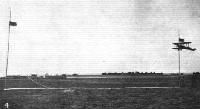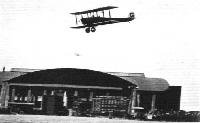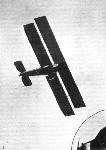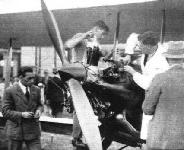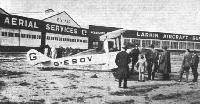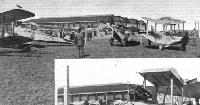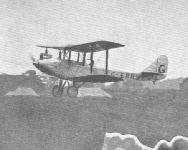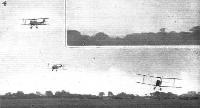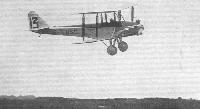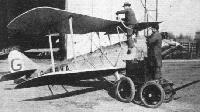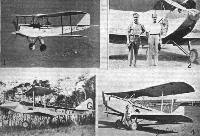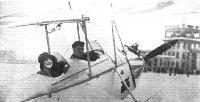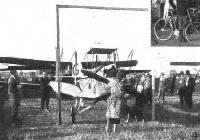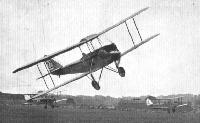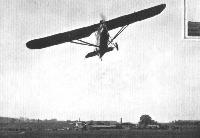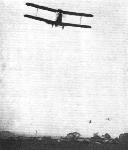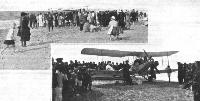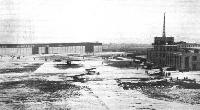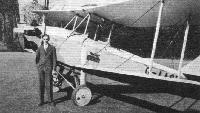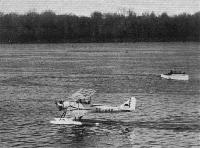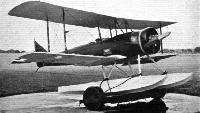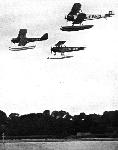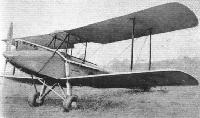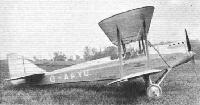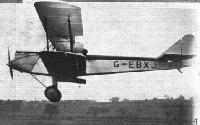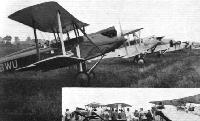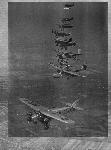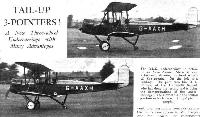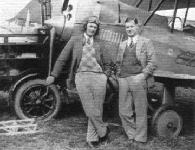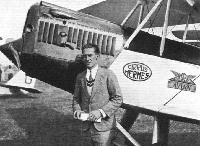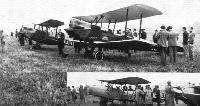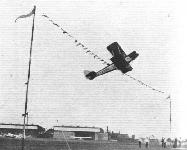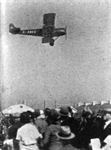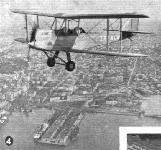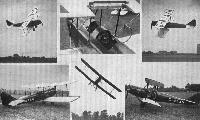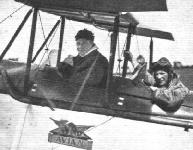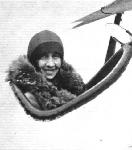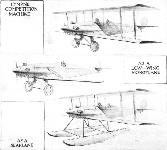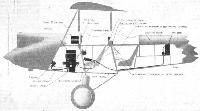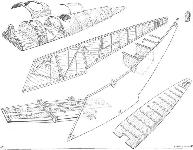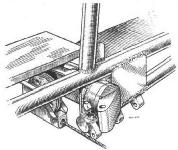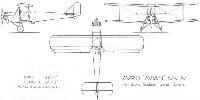
Варианты
- Avro - Avian / Type 594/616 - 1926 - Великобритания
- Avro - Avian Monoplane / Type 625 - 1930 - Великобритания
Avro серии 594 и серии 616 Avian
Avro серии 594 Avian появился в 1926 году, через год после аналогичного de Havilland DH.60 Moth. Его построили для соревнований двухместных легких самолетов на приз газеты "Дейли мейл", проходивших в Лимпне в сентябре 1926 года. Это важное состязание преследовало далеко идущие цели - вывести "de Havilland" в передовые ряды европейских конструкторов легких самолетов.
Прототипом Avian стал самолет серии 581, оснащенный звездообразным двигателем Armstrong Siddeley Genet мощностью 75 л.с. (56 кВт). Модифицированный прототип серии 581A летал с рядным двигателем ADC Cirrus мощностью 80 л. с. (60 кВт) и добился определенных успехов в гонках и полетах на дальность, кульминацией которых стал 15-дневный перелет из Кройдона в Дарвин, Северная Австралия, после доведения самолета до стандарта серии 581E.
За двумя предсерийными машинами серии 594 Avian Mk I последовали девять серийных Avian Mk II. Шесть из них оснащались тем же мотором Cirrus, но имели отличия в конструкции шасси. Еще три машины для Австралии получили моторы Genet II мощностью 75 л. с. (56 кВт).
Первый Avian Mk III с ADC Cirrus II мощностью 85 л.с. (63 кВт) взлетел в середине 1927 года и отличался от Mk II лишь более тонкими стальными межкрыльевыми стойками. Всего построили 33 Avian Mk III, в том числе один для британских ВВС. Затем появились три Avian Mk IIIA, отличавшиеся двигателем Cirrus Mk III мощностью 90 л.с. (67 кВт) и построенные для участия в гонках за Королевский кубок. Серийных Avian Mk IIIA с усиленным каркасом выпустили 58 штук. По меньшей мере, два самолета из них имели поплавковое шасси.
Финальным вариантом стал Avian Mk IV с модифицированными элеронами и шасси. В качестве силовой установки снова выбрали Cirrus III. Большую часть Mk IV продали на экспорт.
В канун Второй мировой войны большинство уцелевших Avian использовались как учебные макеты, но четыре аэроплана сохранились и были зафиксированы в британском гражданском регистре, еще два сняли с военной эксплуатации.
Наряду с Avian деревянной конструкции выпускалась серия 616 Avian Mk IVM со стальным трубчатым каркасом фюзеляжа. В1 929 году проводились испытания такого самолета с мотором Cirrus III. Большая масса самолета потребовала более мощный двигатель, поэтому первые серийные Mk IVM имели либо Cirrus Hermes мощностью 105 л.с. (78 кВт), либо Genet Major мощностью 100 л. с. (75 кВт). 18 таких машин с двигателями Genet Major мощностью 135 л.с. (101 кВт) были построены в Канаде для местных ВВС. Как минимум пять машин собрала в США фирма-импортер.
Построили также небольшую партию самолетов серии 616 Sports Avian с двигателями Hermes мощностью 105 л.с. (78 кВт) или de Havilland Gipsy мощностью 100- 120 л.с. (75-90 кВт). Среди необычных разновидностей этой машины можно назвать монопланы серии Avian 625, один с двигателем Genet Major, другой - с Hermes. Оба самолета списали к концу Второй мировой войны.
Один Avian Mk IVA под названием "Малый Южный крест" был построен как дальний одноместный самолет для пилота Чарльза Кингсфорда-Смита. На Avian MkV, полученном от Кингсфорда-Смита, У. Н. Ланкастер попытался в апреле 1933 года совершить перелет из Англии в Кейптаун. Никаких известий о Ланкастере не было, пока в марте 1962 года в Сахаре не были найдены обломки его самолета.
Варианты
В рамках каждого обозначения выпускались многочисленные субмодификации, поэтому в нижеприведенном перечне описаны только основные варианты:
Серия 581 Avian: единственный прототип, впоследствии модифицированный в серию 581A и серию 581E
Серия 594 Avian Mk I: два предсерийных самолета с опущенной рамой крепления двигателя и шасси с раздельными полуосями
Серия 594 Avian Mk II: девять первых серийных самолетов
Серия 594 Avian Mk III: 33 самолета, в основном аналогичные Avian Mk II, за исключением трубчатых стальных межкрыльевых стоек
Серия 594 Avian Mk IIIA: 58 серийных самолетов с усиленным каркасом
Серия 594 Avian Mk IV: 90 самолетов, дальнейшая разработка Avian Mk IIIA с измененными элеронами и шасси
Серия 605 Avian: два гидросамолета, переделанных из Avian Mk IIIA
Серия 516 Avian Mk IVM: примерно 190 самолетов со стальным каркасом фюзеляжа
Серия 616 Sports Avian: одноместный вариант с улучшенной аэродинамикой, предназначенный для авиагонок
Серия 616 Avian Mk IVA: спецсамолет для сэра Чарльза Кингсфорда-Смита с рядным двигателем de Havilland Gipsy мощностью 120 л.с. (90 кВт) и увеличенным запасом топлива, обеспечивающим дальность 2736 км
Серия 616 Avian Mk V: дальний одноместный самолет, сделанный по заказу сэра Чарльза Кингсфорда-Смита
Серия 625 Avian Monoplane: два низкоплана с расчалочным крылом и шасси в обтекателях
ТАКТИКО-ТЕХНИЧЕСКИЕ ХАРАКТЕРИСТИКИ
Avro серии 594 Avian Mk IIIA
Тип: двухместный туристский самолет
Силовая установка: один рядный двигатель ADC Cirrus III мощностью 90 л. с. (67 кВт)
Характеристики: максимальная скорость 164 км/ч на оптимальной высоте; крейсерская скорость 140 км/ч на оптимальной высоте; начальная скороподъемность 198 м/мин; практический потолок 5485 м; дальность полета 644 км
Масса: пустого самолета 424 кг; максимальная взлетная 651 кг
Размеры: размах крыла 8,53 м; длина 7,39 м; высота 2,59 м; площадь крыльев 22,76 м:
Описание:
- Avro серии 594 и серии 616 Avian
- Flight, August 1926
THE AVRO "AVIAN" - Flight, September 1926
British Light ‘Plane Development & Lympne Meeting - Flight, March 1928
THE AVRO "AVIAN III” - Flight, October 1928
British Exhibits At The Berlin Aero Show 1928 - Flight, June 1929
BRITISH AIRCRAFT AT OLYMPIA
Фотографии
-
Aeroplane Monthly 1979-03 / Avro 581E Avian /Preservation Profile/ (71)
Регистрационный номер: G-EBOV [15]
-
Aeroplane Monthly 2000-02 / J.Maynard - At the sharp end /In the workshop/
Регистрационный номер: VH-UFZ [3] The Avian near Brooklands on June 16, 1998
Vintech rebuilt the D.H. Gipsy engine for Lang Kidby’s England-Australia Avro Avian following its crash in Suffolk. The company also rebuilt the Chevrolet engines which originally powered Vickers Vimy replica NX71MY, and has done powerplant work for the Royal Navy Historic Flight Swordfish, two Yak-11s, Torquil Norman’s transatlantic-flight Leopard Moth and Dragonfly, and Classic Wings’ Duxford-based Rapide, among others. -
Aeroplane Monthly 1998-12 / M.Oakey, T.Harmsworth - News
Регистрационный номер: VH-UFZ [3] Lang Kidby and Avro Av ian VH-UFZ - complete with Aeroplane's new logo on the fuselage side - at Parma airshow in Italy on September 20, 1998.
-
Aeroplane Monthly 1979-03 / Avro 581E Avian /Preservation Profile/ (71)
Регистрационный номер: G-EBOV [15] As the Genet-engined Avro 581 for the 1926 Light Aeroplane Trials.
-
Flight 1926-09 / Flight
No. 9. THE AVRO "AVIAN": Three-quarter front view.
-
Flight 1926-09 / Flight
THE TWO AVRO'S IN THE TESTS: 4, the "Avian" makes light of the take-off test, in spite of a useful load of 828 lbs.
-
Flight 1926-09 / Flight
Winning the S.M.M.T. Race: Hinkler on the Avro "Avian" with Armstrong-Siddeley "Genet" engine won this race at an average speed of 90 m.p.h.
-
Flight 1926-09 / Flight
THE LANCASHIRE AIR PAGEANT: The Avro "Avian" and the de Havilland "Moth," both with "Genet" engines, starting neck-and-neck in the Open Handicap.
Другие самолёты на фотографии: De Havilland Genet Moth - Великобритания - 1926
-
Flight 1926-09 / Flight
"BANKING ACCOUNTS" AT LYMPNE: 1 shows the Avro "Avian" in the Grosvenor Handicap.
-
Flight 1926-12 / Flight
THE TWO AVRO'S IN THE TESTS: 1, Hinkler lands the "Avian" without difficulty.
-
Flight 1926-09 / Flight
LINE UP FOR THE S.M.M.T. RACE: From left to right the machines are: de Havilland "Moth," Avro "Avian," Farnborough "Cygnet," Parnall "Pixie," and Bristol "Brownie." This race was won by Hinkler on the Avro "Avian," at an average speed of 90 m.p.h.
Другие самолёты на фотографии: Bristol Brownie / Type 91 - Великобритания - 1924De Havilland Genet Moth - Великобритания - 1926Hawker Cygnet - Великобритания - 1924Parnall Pixie - Великобритания - 1923
-
Flight 1926-09 / Flight
SOME PERSONAL TOUCHES: The daily toilette: Hinkler having the petrol tank of his Avro "Avis" put on board again after one of its many visits to Hythe.
-
Flight 1926-09 / Flight
MAKING BOTH ENDS MEET: The Tail and the Engine Mounting of No. 9, the Avro "Avian." The engine is an Armstrong-Siddeley "Genet."
-
Flight 1927-04 / Flight
Регистрационный номер: G-EBOV [15] A LONG-DISTANCE JOB: The Avro "Avian," with "Cirrus" Mark II. engine, on which Mr. Bert Hinkler (standing by the machine) proposes to make a flight to Australia shortly. Note the neat nose which the in-line "Cirrus" has made possible.
-
Мировая Авиация 82
Регистрационный номер: G-EBOV [15] 7-22 февраля 1928г.: скуадрон-лидер Берт Хинклер на своем аэроплане Avro Avian (код G-EBOV) вылетел из Кройдона (Великобритания) в первый одиночный перелет в Австралию. 15 дней спустя, преодолев 17700 км над Италией, Мальтой, Ливией, Индией, Бирмой и Сингапуром, он прилетел в Дарвин.
-
Flight 1928-03 / Flight
Регистрационный номер: G-EBOV [15] This is the great "little" Australian pilot, Mr. "Bert" Hinkler, who has stirred the world with his flight to Australia in 16 days as much as Lindbergh did with the lone Atlantic flight last year.
-
Flight 1928-11 / Flight
Регистрационный номер: G-EBOV [15] Mr. "Bert" Hinkler, who has now returned to England, is here seen with his Avro "Avian" (Cirrus) at the Larkin Aircraft Company's works at Melbourne during his aerial tour round Australia this year following his record flight from England.
-
Aeroplane Monthly 1979-03 / Avro 581E Avian /Preservation Profile/ (71)
Регистрационный номер: G-EBOV [15] -
Aeroplane Monthly 1979-03 / Avro 581E Avian /Preservation Profile/ (71)
Регистрационный номер: G-EBOV [15] Chadwick, Hinkler and R.O.J.Parrott with 'BOV, January 1928.
-
Aeroplane Monthly 1982-10 / P.Capon - Capon's Corner
Регистрационный номер: G-EBQN [5] The Avro Type 591 Avian I G-EBQN photographed outside the Avro Hamble works in April 1927. Powered by an 85 h.p. ADC Cirrus II engine, this Avian spent much of its life with the RAE Aero Club at Farnborough. During the war it was impressed as an instructional airframe for use at Eastchurch.
-
Flight 1929-07 / Flight
Регистрационный номер: G-EBQN [5] HULLO, TWINS!: F./O. G. Thorne on the Avro "Avian I" ("Cirrus II") and "J. Wellworth" on the Westland "Widgeon III" ("Genet"), who started together, flew the course together, and finished together!
Другие самолёты на фотографии: Westland Widgeon - Великобритания - 1924
-
Flight 1927-05 / Flight
Регистрационный номер: G-EBQN [5] THE PRODUCTION TYPE "AVIAN": One of the first Avro "Avians" to be completed under quantity production conditions was purchased by the R.A.E. Aero Club of Farnborough (the amateur designers and constructors of the "Hurricane" and "Sirocco" machines), and was used, almost immediately after delivery, for racing in the various events at the Bournemouth Easter Meeting. This is the machine shown in the photograph, the registration letters being G-EBQN. The engine is a "Cirrus" Mark II.
-
Flight 1928-12 / Flight
At a first glance it may seem that this is a picture of an Avro "Avian" (Cirrus) amidst the snow at St. Moritz. Actually it was taken at Woodford Aerodrome, Cheshire, the home of the Lancashire Aeroplane Club
-
Flight 1927-09 / Flight
AVRO "AVIAN" FOR SOUTH AFRICA: The machine has been presented to the S.A. Aero Club by the directors of the "Shell" Company. In the photographs are :- From left to right, Mr. R. H. Dobson, Avro works manager; Mr. J. S. Cartwright, South African manager of the "Shell" Company; Capt. "Jerry" Shaw, Mr. Hill, and Mr. Sharp, all of the "Shell" Company.
-
Flight 1927-09 / Flight
The "Avian" in Latvia: After his recent nonstop flight to Riga, Mr. Bert Hinkler took the opportunity to demonstrate his Avro "Avian." He is here seen at Riga with a group of Latvian air officers, including Lieut.-Col. Skourbe, Commander of the Latvian Air Force, Gen. Roushkevitch, and Lieut.-Col. Indan, Chief of the Military Aviation School.
-
Flight 1927-09 / Flight
The Zurich Meeting: The Avro "Avian" during the light aeroplane race, directly after winning the Basle Cup for greatest speed between St. Gallen and Basle. On the extreme right is Capt. Gsell, who did the course after the last competitor. Next to him is Major Koepke, the Commandant of the aerodrome.
-
Flight 1927-09 / Flight
For Scotland: Mrs. Eliott-Lynn left Woodford Aerodrome on September 2, in her "Avian," to lecture in Scotland for a fortnight on behalf of the Air League of the British Empire. She was accompanied by her secretary (seen on the right of the "Avian" and Mr. Hollindrake (on the left), the latter flying his own "Avian." Amongst the places that will be visited are Dundee, Perth, Aberdeen, Glasgow, Ayr and Edinburgh.
-
Air Pictorial 1992-02 / P.Jarrett - Karachi collection
Регистрационный номер: G-EBTU [5], VH-UTU [4] AVRO 594 Avian G-EBTU was taken from the Avian II production line to be modified as a Mk.III with overload fuel tanks and an 85 h.p. ADC Cirrus II engine. Named Red Rose, after Lancashire’s county emblem, it was used for a flight to Australia by Capt W. H. Lancaster, in company with Mrs Keith Miller. The pair left Croydon on 14 October 1927 and, after various mechanical problems, reached Darwin on 19 March 1928. This study of Capt Lancaster and Mrs Miller with their aeroplane at Karachi was taken some time before 10 January 1928, the date that they reached Muntok in the Dutch East Indies. The machine became VH-UTU in Australia, and survived until 1936.
-
Flight 1927-07 / Flight
THE MARCHIONESS OF TOWNSHEND'S AERIAL FETE: The young Marquis of Townshend selling a programme to Mr. Bert Hinkler
-
Flight 1927-09 / Flight
Регистрационный номер: G-EBOV [15] The "Avian" in Latvia: Mr. Hinkler's machine is the object of a close inspection by the flying personnel. The folding undercarriage was much admired. Note how low the nose comes when the wings are folded and the tail raised, thus facilitating inspection of the engine.
-
Flight 1927-06 / Flight
Регистрационный номер: G-EBOV [15] THE BRISTOL FLYING MEETING: The winner of this race, Mr. Bert Hinkler's "Avian," with its new undercarriage.
-
Flight 1927-06 / Flight
Регистрационный номер: G-EBOV [15] THE BRISTOL FLYING MEETING: "Moths" and "Avians" in the Utility Race.
Другие самолёты на фотографии: De Havilland Moth / D.H.60 - Великобритания - 1925
-
Flight 1927-07 / Flight
Регистрационный номер: G-EBRS [2] A Useful Flight: Mrs. Eliott-Lynn beside her new machine, an Avro "Avian," Mk.II, at the Woodford Aerodrome, from which she started on her 1,200-mile flight at dawn on July 19, making 79 landings on the way and finishing the same night at Newcastle.
-
Flight 1927-07 / Flight
Регистрационный номер: G-EBRR ONE OF THE AIR LEAGUE CUP COMPETITORS: Mr. Cantrill (Lancashire Ae.C.) starts off for Woodford on the new Avro "Avian" ("Cirrus II").
-
Flight 1927-08 / Flight
Регистрационный номер: G-EBQL [6] SOME STARTERS IN THE KING'S CUP RACE: D. A. N. Watt gets away on his "Avian." In the background, the Blackburn "Bluebird" and the Westland "Widgeon III" waiting to start.
Другие самолёты на фотографии: Blackburn Bluebird / L.1 - Великобритания - 1924Westland Widgeon - Великобритания - 1924
-
Flight 1927-08 / Flight
Регистрационный номер: G-EBRS [2] "CRAZY-FLYING" AT NOTTINGHAM: Sqdn.-Leader Jack Noakes demonstrating the error of ordinary aerodynamic theory on Mrs. Eliott-Lynn's Avro "Avian."
-
Flight 1927-10 / Flight
Регистрационный номер: G-EBTP BRISTOL CLUB'S MEETING: Mr. Hollindrake taking up a passenger in an Avro "Avian."
-
Aeroplane Monthly 1981-09 / A.Wheeler - The Bournemouth Easter Meeting
Good Friday at Bournemouth; 1, Hinkler on the Avian G-EBOV rounding the aerodrome turning point.
-
Flight 1927-04 / Flight
Регистрационный номер: G-EBQL [6] A FEW MORE GOOD FRIDAY PICTURES: 2, Cantrill rounding the turning point in second heat of the Final of the Branksome "Cirrus" Handicap.
-
Flight 1927-06 / Flight
Регистрационный номер: G-EBQL [6] THE BRISTOL FLYING .MEETING: 2, shows "Dangerous Dan" flying in an "Avian" and a trilby hat.
-
Flight 1931-01 / Flight
Регистрационный номер: ZS-AAC The Cape Town Flying Club's first Avro "Avian," which was presented to them by the "Shell" Co. Our reader writes that this club has had to close down as it was unable to pay its way without a Government subsidy.
-
Flight 1928-06 / Flight
CRAZY FLYING - SLOTTED AND OTHERWISE: Sqdn.-Ldr. Noakes adds a few new spasms to his repertoire of crazy flying on the Avian with Handley-Page slots.
-
Flight 1927-05 / Flight
THE HAMPSHIRE AIR PAGEANT: Event 6, the President's Cup Race. Bert Hinkler well away on his Avro "Avian" ("Cirrus"), with new landing chassis.
-
Flight 1927-06 / Flight
Регистрационный номер: G-EBQL [6], G-EBQN [5] TWO "AVIANS": Watt on 'QL just beats Gray on 'QN in the second heat of Hotels Association Sweepstake. The final of this race was also won by Watt, with Gray third.
-
Aeroplane Monthly 1979-03 / Avro 581E Avian /Preservation Profile/ (71)
Регистрационный номер: G-EBOV [15] AT THE BOURNEMOUTH MEETING: 4, Bert Hinkler on his "Avian" leads Broad on the "Moth" in the Final of the Hotels and Restaurants Race.
Hinkler flying the Avian in 581E form, Bournemouth, Easter 1927. -
Flight 1927-04 / Flight
A FEW MORE GOOD FRIDAY PICTURES: 4, Third, fourth and fifth in Branksome "Cirrus" Handicap were: Pope on PG, Stack on PU, and Gray on QN.
Другие самолёты на фотографии: De Havilland Moth / D.H.60 - Великобритания - 1925
-
Flight 1928-07 / Flight
OPEN HANDICAP: Miss W.S. Brown, (centre) on her Avro "Avian" (Cirrus), winning the Open Handicap from Capt. Baker on an Avro "Avian" and Flight-Lieut. T. Rose on the D.H. "Moth" by two seconds.
Другие самолёты на фотографии: De Havilland Moth / D.H.60 - Великобритания - 1925
-
Flight 1927-09 / Flight
HOOTON AIR PAGEANT: (4) Mrs. Eliott-Lynn on Avian "QL" (left), Mr. Fielding on Bluebird "SV" (middle), and Mr. Lacayo on Moth "MF" (right) coming in at the end of the first lap in Inter-Club Members' Race.
Другие самолёты на фотографии: Blackburn Bluebird / L.1 - Великобритания - 1924De Havilland Moth / D.H.60 - Великобритания - 1925
-
Aeroplane Monthly 1981-09 / A.Wheeler - The Bournemouth Easter Meeting
GOOD HANDICAPPING: Four machines approaching the finishing line in the first heat of the Holiday Final Handicap on Easter Monday. The machines are, in the order of finishing: OU (Sempill), QL (Cantrill), JT (Openshaw), and KQ (Hamersley).
Two Moths, a Widgeon and an Avro 504 approach the finishing line in another race.Другие самолёты на фотографии: Avro Avro 504N - Великобритания - 1920De Havilland Genet Moth - Великобритания - 1926Westland Widgeon - Великобритания - 1924
-
Flight 1927-06 / Flight
THE PRIVATE OWNERS' HANDICAP: The machines are here seen approaching the aerodrome turning point at the conclusion of the second lap. Mr. Norman Jones was so far ahead as to be out of the picture. The others are, in the order given - Longton, on the "Bluebird," de Havilland on "Moth" NO, Col. Sempill on D.H. 51, Hinkler on his "Avian," Lady Bailey on her "Moth," PU, and Scroggs on the Westland "Woodpigeon."
Другие самолёты на фотографии: Blackburn Bluebird / L.1 - Великобритания - 1924De Havilland D.H.51 - Великобритания - 1924De Havilland Moth / D.H.60 - Великобритания - 1925Westland Wood Pigeon - Великобритания - 1924
-
Flight 1927-06 / Flight
Регистрационный номер: G-EBQL [6], G-EBQN [5] THE BRISTOL FLYING .MEETING: 1, Line-up for the Final of the First Handicap Race. The machines include, from left to right, the Halton "Mayfly," Lady Bailey's "Moth" PU, Watt's "Avian," QL, and the Farnborough Club "Avian," QN.
Другие самолёты на фотографии: De Havilland Moth / D.H.60 - Великобритания - 1925Halton H.A.C.1 Mayfly/H.A.C.2 Minus - Великобритания - 1927
-
Aeroplane Monthly 1981-09 / A.Wheeler - The Bournemouth Easter Meeting
Регистрационный номер: G-EBOV [15] GOOD FRIDAY AT BOURNEMOUTH: 5, the line-up of the Poole Handicap with Watt nearest the camera.
Другие самолёты на фотографии: RAF S.E.5 - Великобритания - 1916
-
Flight 1927-09 / Flight
The Zurich Meeting: The glider shown in this photograph was repeatedly towed behind a Fieseler aeroplane and released, landing in front of the judges' stand. In background may be seen the Avro "Avian."
Другие самолёты на фотографии: Raab-Katzenstein RK.6 / RK.7 Schmetterling - Германия - 1927
-
Flight 1930-01 / Flight
"Bert" Hinkler adjusting the "Cirrus" engine of his Avro "Avian" light 'plane before setting out on his remarkable lone flight from England to Australia in 1928. He accomplished the journey to his native land in the record time of 14 days, and on arriving there flew on to his home town and other parts of the Commonwealth - naturally receiving an enthusiastic reception everywhere.
-
Flight 1928-02 / Flight
HINKLER'S FLIGHT TO AUSTRALIA: On the left, the "Great Little Man" is seen at work on his engine. On the right a "close-up" of the special vice Hinkler has made. This fits on an engine bearer, and enables work, such as adjusting a tappet rod or dismantling a sparking plug, to be carried out with convenience. The short air intake pipe has, where it joins the carburettor a "choke plate" which Hinkler uses for starting, in place of the usual rag. The "Avian" bristles with special "gadgets" thought out by Hinkler.
-
Flight 1928-02 / Flight
Регистрационный номер: G-EBOV [15] HINKLER'S FLIGHT TO AUSTRALIA: Two views of the special "K" type jury strut used by Hinkler for folding the wings of his "Avian". The photograph on the left shows the "K" strut in place, while on the right it is seen partly folded. A single bolt in the centre is undone, and the two halves of the "K" strut then fold into lower and upper wing respectively, where they are housed in slots in such a way as to fair in with the wing surfaces.
-
Flight 1928-02 / Flight
Регистрационный номер: G-EBOV [15] HINKLER'S FLIGHT TO AUSTRALIA: This view of the "Avian" with wings folded gives a good idea of the way in which Hinkler's special type of undercarriage lowers the front of the machine and makes the "Cirrus" engine very accessible. Also the wheels move aft and relieve the tail skid of nearly all its load.
-
Flight 1927-07 / Flight
Регистрационный номер: G-EBSD [3] The Avro "Alpha-Avian" is fitted with the new Avro Alpha engine.
-
Flight 1927-08 / Flight
Регистрационный номер: G-EBSD [3] THE NOTTINGHAM FLYING MEETING: Hinkler on the Avro "Alpha-Avian" in the Grosvenor Cup.
-
Flight 1927-09 / Flight
Hooton Air Pageant: Squadron-Leader J. Noakes giving an exhibition of his famous crazy flying on an Avro Avian. He also put an Avro Gosport through his crazy tricks. These events were very popular.
-
Flight 1928-10 / Flight
BRITISH AIRCRAFT AT BERLIN: The Avro "Avian" light 'plane, fitted with the Armstrong-Siddeley "Genet II" engine.
-
Flight 1928-03 / Flight
THE AVRO "AVIAN III": Three-quarter front view. Note the neat engine cowling and "clean" nose.
-
Flight 1928-01 / Flight
The Avro "Avian" (30-80 h.p. "Cirrus" Engine), which is to operate with the Seal Fisheries in Newfoundland in place of the Avro "Baby," the latter now retiring after several years of useful work.
-
Flight 1928-10 / Flight
BRITISH AIRCRAFT AT BERLIN: The Avro "Avian" light 'plane, fitted with the A.D.C. "Cirrus II" engine.
-
Flight 1927-10 / Flight
Регистрационный номер: G-EBTU [5], VH-UTU [4] FLIGHT TO AUSTRALIA: An Avro "Avian" light aeroplane will leave Croydon within the next few days on a flight to Australia. The pilot is Capt. W. N. Lancaster, R.A.F. (Res.), and the passenger is Mrs. Keith Miller, wife of a well-known Australian journalist. The machine is fitted with a 32/80 h.p. Cirrus engine, and is a standard machine except for having larger tanks fitted. The route will be via Paris, Lyons, Marseilles, Rome, Naples, Malta, Khoms and Benghasi in African Italy, Sollum in Egypt, thence via Irak, Persia, Calcutta, Singapore, the Dutch East Indies, to Port Darwin, Australia, and it is planned that the flight will take from five to six weeks. The "Avian" will carry a letter from the High Commissioner in London to the Prime Minister of the Commonwealth of Australia. It has been christened the "Red Rose," as Capt. Lancaster is a Lancastrian.
-
Flight 1927-10 / Flight
Регистрационный номер: G-EBTU [5], VH-UTU [4] To Australia by Light Aeroplane: Capt.W.N. Lancaster and his passenger, Mrs. Keith Miller, in their "Red Rose" before the departure for Australia from Croydon on October 14. In this Avro "Avian" they reached Pisa from Marseilles on October 19, and Rome and Naples the next day. On October 21 Catania in Sicily was gained, and Malta the following day. On October 24 the "Red Rose" reached Tripoli, North Africa. This "Avian" is fitted with the Cirrus 32/80 h.p. engine. Capt. Lancaster is an officer in the Air Force Reserve and his passenger is the wife of a well-known Australian journalist.
-
Aeroplane Monthly 1988-03 / Personal album. Civil
Регистрационный номер: G-EBTU [5], VH-UTU [4] Avro Avian G-EBTU, the prototype Type 594 Mk III, was built in 1927 and sold to Capt Bill Lancaster. Named Red Rose, for obvious reasons, the Avian was flown to Australia between October 14, 1927 and March 19, 1928. In May that year it was sold in Australia and became G-AUTU, later becoming VH-UTU. On June 6, 1936 the Avian was burnt out at Singleton in New South Wales.
-
Aeroplane Monthly 1986-09 / Grapevine
Регистрационный номер: G-EBTU [5], VH-UVX [2] Avro Avian VH-UVX.
-
Flight 1928-02 / Flight
Регистрационный номер: G-EBUG AN "AVIAN" IN SOUTH AFRICA: In this interesting group discussing the unpacking of Lady Heath's "Avian" at Cape Town will be noticed Sir James Heath (with walking stick) and Lady Heath, whilst stroking the glossy neck of the horse is Col. Henderson. The lady rider is Miss Jute, of Johannesburg, who learned to fly with Col. Henderson and was ready to go solo within a week.
-
Aeroplane Monthly 1983-09 / P.Capon - Capon's Corner
Регистрационный номер: G-EBVI [2] The author admires Avro Avian III G-EBVI, in which he took his ticket on October 12, 1929.
-
Flight 1928-02 / Flight
Регистрационный номер: G-EBVI [2] This is the Avro "Avian" which A. V. Roe and Co. have supplied to the Hampshire Aero Club. It is fitted with the new undercarriage which is automatically swept back when the wings are folded, bringing the machine nearer the ground. Thus the engine is more accessible for inspection and adjustment. Also a good deal of weight is taken off the tail skid, thereby facilitating the manoeuvring of the machine. These photographs were taken at Woodford Aerodrome, Cheshire, after the machine had been tested.
-
Flight 1928-05 / Flight
Регистрационный номер: G-EBVU THE BRISTOL AIR PAGEANT: A portion of the "Parade." Nearest the camera is a de Havilland "Cirrus-Moth." Ahead of that a Westland "Cirrus-Widgeon," an Avro "Cirrus-Avian" and a Blackburn "Genet-Bluebird."
Другие самолёты на фотографии: Blackburn Bluebird / L.1 - Великобритания - 1924De Havilland Moth / D.H.60 - Великобритания - 1925Westland Widgeon - Великобритания - 1924
-
Flight 1930-04 / Flight
Регистрационный номер: G-EBVZ [4] The line up for the Kingston-upon-Hull Air Race.
-
Flight 1928-05 / Flight
Регистрационный номер: G-EBVZ [4] Taking Over: A new Avro "Avian" going through its acceptance test with Miss Winifred Brown on board, who afterwards purchased it. She is a member of the Lancashire Aeroplane Club and learned to fly as such. One of her recent flights was to Croydon from the north, on the occasion of the visit of the King of Afghanistan.
-
Flight 1930-07 / Flight
Регистрационный номер: G-EBVZ [4] THE END OF A PERFECT DAY: Miss Brown's "Avian" is seen at the moment of crossing the finishing line.
-
Flight 1929-07 / Flight
Регистрационный номер: G-EBVZ [4] GETTING THEM DOWN AT WAALHAVEN: Various styles of landing over the tape are shown. 8. Miss Brown, "Cirrus-Avian."
-
Flight 1928-03 / Flight
Регистрационный номер: G-EBWK [4] THE AVRO "AVIAN III": Three-quarter rear view.
-
Air-Britain Archive 1980-01
Регистрационный номер: G-EBWK [4] An evocative shot of Avro Avian G-EBWK taken 8.3.28 at an unidentified, but misty, location.
-
Flight 1928-03 / Flight
Регистрационный номер: G-EBWK [4] THE AVRO "AVIAN III": This view shows the machine with the port wings spread and the starboard wings folded, to illustrate how undercarriage wheels move back when wings are folded. The telescopic jury struts fold flat aganst the top plane when in flight.
-
Flight 1928-03 / Flight
Регистрационный номер: G-EBWK [4] THE AVRO "AVIAN III": Three views of the machine in flight, as a landplane, and a view of it fitted with floats.
-
Aeroplane Monthly 1977-11 / R.Brett - My first solo
Регистрационный номер: G-EBWU [3] 'WC in company with Avro Avian G-EBWU at Lympne. On July 7, 1928, a club member taxied 'WC, “at great velocity into one of the permanent hangars. The hangar proved to be more permanent than the Moth, which looked uncommonly like a write-off”.
Другие самолёты на фотографии: De Havilland Moth / D.H.60 - Великобритания - 1925
-
Aeroplane Monthly 1989-01 / Personal album. Civil
Регистрационный номер: G-EBWU [3] Avro Avian III G-EBWU lined up for the 1930 King’s Cup race at Hanworth on July 5. Flown by Lt Caspar John RN, the Cirrus II-powered Avian was flown into 28th place. G-EBWU had a number of pre-war owners, and ended its days at Elstree Studios where it was used as a stage prop during the war.
-
Aeroplane Monthly 1991-11 / Personal album. Civil
Регистрационный номер: G-EBXX [2] Completed in 1928 and first owned by the Liverpool & District Aero Club, Avro Avian IIIA G-EBXY was latterly operated by the Blackpool & Fylde Aero Club. In December 1939 'XY was impressed into the RAF and became instructional airframe 2078M. It is pictured here at Stanley Park, Blackpool.
-
Flight 1928-07 / Flight
Регистрационный номер: G-EBXX [2] BLACKPOOL: General View of the Machine Park, with the private light aeroplanes in the foreground, of which there were about 50, and the Royal Air Force machines, which included night bombers, day bombers and single-seater fighters, in the distance.
Другие самолёты на фотографии: De Havilland Gipsy Moth / Moth X - Великобритания - 1928
-
Flight 1929-10 / Flight
Регистрационный номер: G-EBYA Service. B.P. refuelling an Avian from one of their portable pumps.
-
Flight 1928-09 / Flight
Регистрационный номер: G-EBYR [2] TAKING OFF AT ORLY: (1) The Avro "Avian" (Cirrus) flown by Capt. Percival.
-
Flight 1928-09 / Flight
Регистрационный номер: G-EBYR [2] SUCCESSFUL COMPETITORS IN THE 1928 ORLY MEETING: Herr R. Lusser (left) won with 1,691 points on the Klemm (Salmson) machine shown above him. Capt. E. W. Percival (centre) was second with 1,606 points on the Avro "Avian" (Cirrus Mk. III) (above); and Capt. H. Broad (right) third with 1,581 points on the Gipsy-Moth (above).
Другие самолёты на фотографии: Daimler L 20 - Германия - 1924De Havilland Gipsy Moth / Moth X - Великобритания - 1928
-
Aeroplane Monthly 1986-01 / 1986 UK Aircraft Collections and Museums Guide
Регистрационный номер: G-EBZM [2] Pre-war picture of Avian G-EBZM.
-
Air Pictorial 1958-03
Регистрационный номер: G-EBZM [2] An effort to reconstruct the Avian IIIA, G-EBZM (c/n. R3/CN/160), which has been in store at Southport, is now being made in the Manchester area.
-
Flight 1929-06 / Flight Advertisements
Регистрационный номер: G-AACV [2] On March 2nd of this year, Mr. Wenlin Chen left Croydon Aerodrome in an Avro Avian. On May 10th, he arrived at Amoy, China. Throughout this 14,000 mile flight across Europe and Asia no trouble was experienced, and Mr.Wenlin Chen expressed complete satisfaction with the machine. This Avro Avian is one of fourteen ordered by the Chinese Government for a school to be opened at Nanking
The lighter, smaller Avro-Avian is specially suited for flying clubs. 100 m.p.h. 20 miles per gallon. -
Flight 1929-10 / Flight
Регистрационный номер: G-AAEC [2] The line-up and winners of two of the three racing events at the Newcastle Pageant. Top: Air League Challenge Cup: N. S. Todd. Bottom, Grosvenor Challenge Cup: G. S. Kemp. Both of Newcastle!
-
Flight 1929-03 / Flight
Регистрационный номер: G-AAEC [2], G-EBYP AVRO "AVIANS" AT HOME AND ABROAD: (1) The Lancashire Aero Club's new Avro "Avian" flying over Woodford Aerodrome during the acceptance test by Mr. Hall, Chief Instructor. Note the new type undercarriage. (2) Mr. R. S. Adair (left), a pilot of Aircrafts Proprietary, Ltd., with the official of General Motors Acceptance Corporation, at the conclusion of their 1,500 miles tour of Queensland, Australia, in an Avro "Avian." (3) A very good close-up of a stalled landing on the "Avian" fitted with Handley Page slots. (4) Miss Lya de Putti, the Hungarian film star, nestling to her own "Avian" at the Grand Central Air Terminal, New York. She is now in England and is sending to America for her machine.
-
Aeroplane Monthly 1985-04 / N.Ewart - When flying was still an adventure (1)
Регистрационный номер: G-AAHE [2] The Avro Avian owned by the chief ground engineer of the Yapton Aero Club. The author flew the owner in Spartan Three Seater G-ABLJ to pick up the Avian from Croydon.
-
Flight 1929-07 / Flight
Регистрационный номер: G-AAHJ [4] SOME OTHER COMPETITORS: (4) Capt. T. N. Stack, who nearly won, on the "Hermes-Avian."
-
Aeroplane Monthly 1989-12 / R.Bentley - Swiftly with Shell
The Shell-Mex & BP aircraft fleet in 1933. The Company Swift G-ABUS is at right, Puss Moth G-AAXY is in the centre with Avro Avian G-ABIB, or G-ABIM, in the background.
Другие самолёты на фотографии: Comper Swift / CLA.7 - Великобритания - 1930De Havilland Puss Moth / D.H.80 - Великобритания - 1929
-
Flight 1929-04 / Flight
Регистрационный номер: G-NZEE The Avro "Avian" inducing air-mindedness into the people of Napier, a town in the North Island of New Zealand, where an aero club is being formed. On the occasion when these machines were flying, about 300 people were flown at one guinea each.
-
Flight 1928-08 / Flight
Регистрационный номер: M-CDAD AVIANS "EX WORKS." - A batch of Cirrus-Avians at Woodford ready for collection. It will be seen that the one nearest the camera bears Spanish registration marks. The Spanish agent finds it quicker and cheaper to fly his Avians to Spain than to ship them.
-
Air-Britain Archive 1983-04
Регистрационный номер: CX-AAB CX-AAB inscribed simply "Accidente del Avian 1937".
-
Aeroplane Monthly 1986-10 / B.Abell - Butler did it!
How it was done in the Twenties and Thirties. Arthur Butler’s Avro Avian being serviced somewhere in the Australian outback.
-
Aeroplane Monthly 1985-08 / Grapevine
Регистрационный номер: VH-UVX [2] Newly restored Avro Avian VH-UVX at Bankstown, New South Wales, Australia, on May 27, 1985. The aircraft was about to leave for Melbourne to take part in the film Red Rose - the story of W.N.Lancaster's successful attempt on the England - Cape record in 1933.
-
Flight 1928-08 / Flight
Mrs. Hilton Philipson, M.P., taking off from Croydon Aerodrome in an Avro "Avian." She is thought to be the first lady M.P. to have flown.
-
Flight 1930-07 / Flight
THE WINNER: Miss Winifred Brown, tired but happy, gives the photographers a chance at Hanworth at the end of the race.
-
Flight 1928-04 / Flight
Visitors to the Lympne Meeting: Mr. and Mrs. F.P.Raynham, with their "Avian," which Mr. Raynham has bought for photographic survey work.
-
Flight 1929-02 / Flight
A USEFUL PAIR: Miss Winifred Brown finds that her Armstrong-Siddeley Car makes a very convenient combination with her Avro "Avian" (Cirrus) light aeroplane. This Lancashire airwoman is as skilful a hockey player as she is motorist and air pilot, and in the North Country she is well known in hockey circles. Miss Brown qualified as a pilot with the Lancashire Aero Club, and has been a private owner for a considerable time.
-
Flight 1929-06 / Flight
This is a section of the Manchester crowd at the Pageant last Saturday watching the Avro "Avian" (their own production) take-off.
-
Flight 1928-05 / Flight
HOME: The Avro "Avian III" ("Cirrus" 30-80 h.p. engine) taxying in at Croydon aerodrome on May 17 after the first solo light 'plane flight from Cape Town to England. In the background are some mechanics of A.D.C. Aircraft whose engine played such a reliable part in Lady Heath's tour.
-
Flight 1935-09 / Flight
A lady victorious: Commander Perrin shepherds in Miss Browns winning Avian at the conclusion of the 1930 contest.
-
Flight 1937-04 / Flight Advertisements
An AVRO "AVIAN" CIRRUS MARK III Won the King's Cup Air Race in 1930.
-
Flight 1928-05 / Flight
Sir.Charles Wakefield's Gift: The Avro "Cirrus-Avian" presented by Sir Charles to the Federal Government was handed over by Mr. Bruce to the Australian Aero Club; (N.S.W. Section) on March 31 at Mascot aerodrome. In the photograph the machine is seen just after being erected at the Larkin Works, Melbourne.
-
Flight 1928-04 / Flight
Capt. H. A. Brown has now joined Avro's "Avian" sales department as demonstrator, and is also the firm's test pilot.
-
Flight 1928-05 / Flight
PENALTY OF FAME: Lady Heath was besieged by photographers at Croydon aerodrome when she landed on May 17, and is here seen facing the battery beside her reliable Avro "Avian" ("Cirrus"). A large crowd raised cheers as she stepped from the machine.
-
Flight 1929-07 / Flight
CIRRUS-AVIAN FLIGHT TO CHINA: Mr. Wen Lin Tschen (left) is now flying to China in this Cirrus-Avian with Mr. Johannsen (right), a Dane. They left Croydon at the beginning of March and were last reported along the Persian Gulf. This is the first attempt to fly from England to China in a British light 'plane.
-
Flight 1928-02 / Flight
SNAPSHOTS FROM SOUTH AFRICA: On the left are Lady Heath, Mr. Brian Russell and Sir James Heath standing before the former's Avro "Avian," which was in course of erection at Young's Field, the aerodrome outside Cape Town. On the right is Lady Heath tightening up the propeller, whilst other energetic workers are seen under the machine and in the rear cockpit.
-
Flight 1928-10 / Flight
THE AVRO EXHIBIT: The two "Avians," that on the left being fitted with an Armstrong Siddeley "Genet II," the other having an A.D.C. "Cirrus II."
-
Flight 1928-09 / Flight
FOLDING TESTS AT ORLY: Our machines showed superiority in the folding tests at the French Light 'Plane Trials. (4) Lady Heath guides her Avro "Avian" safely through in the best time, with Capt. Percival (left) helping.
-
Flight 1928-07 / Flight
THE KING'S CUP AND SIDDELEY TROPHY: Some competitors starting from Hendon on the first stage. Bernard Martin on the Avro Avian (No. 22), Wing-Com. S. W. Smith on the D.H. Moth X (No. 15), and Capt. G. de Havilland on another Moth X, take off together.
Другие самолёты на фотографии: De Havilland Gipsy Moth / Moth X - Великобритания - 1928
-
Flight 1928-07 / Flight
THE KING'S CUP AND SIDDELEY TROPHY: Some competitors starting from Hendon on the first stage. C. E. F. Boyes (left) and E. W. Percival off together, both on Avians fitted respectively with Armstrong-Siddeley "Genet II" and A.D.C. "Cirrus III" engines.
-
Flight 1929-05 / Flight
Mr. Cantrill, in the Avro "Avian," bombing the Austin "Baby."
-
Flight 1928-03 / Flight
The Johannesburg Flying Meeting: A close finish. Lady Heath winning the 12-mile handicap race in her Avro "Avian," with Lieut. Bentley a good second in his D.H. "Moth." Note the big crowd.
Другие самолёты на фотографии: De Havilland Moth / D.H.60 - Великобритания - 1925
-
Flight 1928-05 / Flight
AT HAMBLE: The two Avro "Avians," flown by Flt.-Lieut. Luxmoore and Capt. H. A. Brown, fighting their duel in the Morris Open Handicap, with the former on "XY" leading.
-
Flight 1928-07 / Flight
THE KING'S CUP AND SIDDELEY TROPHY: Some competitors starting from Hendon on the first stage. R. G. Cazalet on a Widgeon III ("Cirrus II"), and just behind him Flight-Lieut. Ragg on an Avian ("Cirrus").
Другие самолёты на фотографии: Westland Widgeon - Великобритания - 1924
-
Flight 1929-10 / Flight
The finish of the Grosvenor Challenge Cup Race: The Newcastle Club's "Moth" 'PT (G. S. Kemp) comes in first with their other "Moth" 'QV (H. L. B. Dixon) second, and the Lancashire Aero Club "Avian " 'EC (A. Goodfellow) third.
Другие самолёты на фотографии: De Havilland Moth / D.H.60 - Великобритания - 1925
-
Flight 1928-09 / Flight
RELIABILITY TRIAL: These are pictures of events during Lady Heath's forced landing on the beach at Trouville in the Avro "Avian." The landing cost her 60 points, for she did not reach Le Havre until the next day.
-
Flight 1928-04 / Flight
Lady Heath's Avro "Avian" (Cirrus) (on photo) and Lt. R. Bentley's D.H. "Moth" (Cirrus) at Broken Hill during the combined flight through Africa.
-
Flight 1928-03 / Flight
The Johannesburg Flying Meeting: An interested group round Lady Heath's "Avian." From left to right: Mr. A. N. Other; Capt. Bellin, Instructor to the Jo'burg Club, Major Miller (in white cap); Glen Bateman, the first soloist of any S. African flying Club; Rod Douglas, Secretary of Jo'burg Club; and behind Lady Heath (in cockpit), Lieut. Bentley.
-
Flight 1929-05 / Flight
Lady Heath has recently completed a flying tour of several American States on behalf of the American "Cirrus" engine. She flew a Cirrus-Avian and acted as her own pilot, mechanic, and saleswoman. About 3,000 miles were covered, and orders were lodged with her, we understand, for over 100 engines.
-
Flight 1928-03 / Flight
LADY HEATH'S TOUR IN SOUTH AFRICA: The arrival of Lady Heath at East London in her Avro "Avian"
-
Flight 1929-01 / Flight
In this general view of Croydon Aerodrome under wintry conditions are the many machines which brought their owners to greet Lady Bailey. They include Capt. G. de Havilland's Coupe-Moth, Mr. G. A. R. Malcolm's Gipsy-Moth and Lt.-Col. L. A. Strange's Simmonds "Spartan." Also in the picture, which was taken from a "D.H." Moth piloted by Capt. A. S. White, are the "Daily Mail" "Geraldine" (D.H.61) and Alpha-Avian.
Другие самолёты на фотографии: De Havilland Giant Moth / D.H.61 - Великобритания - 1927De Havilland Gipsy Moth / Moth X - Великобритания - 1928Simmonds Spartan - Великобритания - 1928
-
Flight 1928-10 / Flight
A STUDY IN "NOSES": On the left the "Cirrus-Avian" and on the right the "Genet-Avian.'' Note the novel arrangement of the exhaust pipes on the latter.
-
Aeroplane Monthly 1982-07 / R.Riding - The 1932 King's Cup air race
Регистрационный номер: G-ABPU The slowest and first machine off in the race was the Avro Avian IIIA G-ABPU flown by J. F. Legard.
-
Aeroplane Monthly 1982-10 / P.Capon - Capon's Corner
Регистрационный номер: G-EBVA [2] The Avro Type 605 Avian III G-EBVA afloat at Hamble in February 1928. Powered by an 85 h.p. ADC Cirrus, this aircraft spent most of its life as a landplane.
-
Flight 1929-06 / Flight
Регистрационный номер: G-AACF The Earl of March with his Avro "Avian" (Armstrong Siddeley "Genet") outside Goodwood House. The registration letters are G-AACF.
-
Flight 1931-06 / Flight
A new version of the Avian, which is now at Heston. It belongs to Cellon, Ltd., and has a 7-cylinder Genet Engine.
-
Flight 1930-04 / Flight
Регистрационный номер: G-AATV -
Flight 1930-02 / Flight
A METAL AVIAN TO SERVE THE SHELL INTERESTS: This machine is one of the latest acquisitions of the Shell-Mex organisation. They are now launching a scheme whereby an attack will be made on the Dominion markets with the aid of aircraft, and this Avian (Genet Major) was christened, together with two Moths (Gipsy), at Croydon Aerodrome on Thursday, February 6.
-
Flight 1935-09 / Flight
Before last year's race: The Avro Avian (Genet Major), which is being flown this year by No. 36, A. H. Tweddle.
-
Flight 1935-09 / Flight
Регистрационный номер: G-ABME [2] The line-up for the Final, with the only biplane, A. H. Tweddle's Avian (Armstrong-Siddeley Genet), in the foreground. Although fairly new to the racing game, Tweedle's flying was remarkably consistent in both Friday's and Saturday's races.
-
Aeroplane Monthly 1988-07 / A.Henshaw - Miles for the Cup! (1)
Регистрационный номер: G-ABME [2] George Reynolds about to flag off A. H. Tweedle in Avro Avian G-ABME, the oldest and slowest aircraft.
-
Flight 1929-12 / Flight
Selling "Aviation" in Singapore. A Genet Major Avian in the showroom of Malayan Motors.
-
Air Pictorial 1957-06 / Photos by request
Регистрационный номер: CF-CAR George Fuller of Montreal has discovered a photograph of an Avro Type 594 Avian powered by a Genet radial . This Canadian Genet Avian 2-seater of the early 1930s was registered CF-CAR. This has a 1957 echo in that an ex-A.N.A. DC-3 recently converted by Timmins Aviation, Montreal, with retractable wheel /ski u/c. and Arctic colours is now CF-CAR.
-
Flight 1932-03 / Flight
Регистрационный номер: G-ABSC An Avro Avian just supplied to A.S.T. for instruction use at Hamble. This Machine is now fitted with Dunlop low-pressure tyres and the Armstrong Siddeley Genet Major Engine.
-
Flight 1929-07 / Flight
This is the Avro "Avian" with Armstrong Siddeley "Genet" engine, which Mr. J. D. Siddeley presented to the Ottawa Flying Club, which now has two of these machines. In the group are (left to right), Capt. L. E. Maynard, Ottawa Club Instructor, Capt. M. Windsor, Canadian Manager of Armstrong Siddeley Motors, Ltd., Mr. W. L. McIntyre, General Manager of the Ottawa Car Co., which constructs Avians under licence, and Mr. L. Roberts, Club Secretary.
-
Flight 1930-05 / Flight
WELL EQUIPPED "AVIANS": A group of five "Avians" equipped with Goodyear Air-wheels and Handley-Page slots, ready for delivery by the Ottawa Car Co., the Canadian licensees for A. V. Roe, Ltd.
-
Flight 1930-06 / Flight
CANADIAN ENTERPRISE: A metal Avro Avian (Genet Major) built in Canada. This aircraft has a wide range of utility in Canada, where the prevalence of lakes and other stretches of water make the seaplane much more practical than the landplane for such work as forest fire patrol and so on.
-
Flight 1930-06 / Flight
Регистрационный номер: CF-AHV ENTERPRISE IN CANADA: An Avro Avian Seaplane (Genet Major) on the Ottawa River.
-
Flight 1932-10 / Flight
FOR SEAPLANE TRAINING: An "Avian" (7-cyl. Armstrong-Siddeley Genet Major) with all-metal "boots," which is used for training seaplane pilots at Hamble by Air Service Training, Ltd.
-
Flight 1932-11 / Flight
Регистрационный номер: G-ABKB [3] AT THE SLIPWAY: A.S.T. have their own slipway at Hamble so that getting their seaplanes afloat does not present much difficulty.
-
Air Enthusiast 1996-05 / R.Bonser - Hamble Pictorial. Air Service Training in the 1930s
Регистрационный номер: G-ABKB [3] AST grouping within the huge Avro/AW works building on the southern airfield. Foreground, left to right: Avro 616 Avian IVM floatplane G-ABKB, entered service in March 1931 and served on until being impressed, as instructional airframe 2073M, in February 1940. Saro A.17 Cutty Sark G-ACDP served AST from April 1933 until April 1939 when it was scrapped. Avro 504N G-EBKQ was converted by Avro at Hamble and flew for them in several capacities, the most famous of which was as Bert Hinkler’s mount in the gruelling 1925 King’s Cup which was staged out of Croydon over 1,608 miles and two days in July. In 1930 it was converted to 5040 seaplane status and joined AST, retiring in June 1931 to act as an instructional airframe.
Другие самолёты на фотографии: Avro Avro 504N - Великобритания - 1920Saunders-Roe Cutty Sark / A.17 - Великобритания - 1929
-
Flight 1932-11 / Flight
Регистрационный номер: G-ABKB [3] WITH "BOOTS" ON: The A.S.T. seaplane fleet flying over our photographer at Hamble. Left to right, the " Avian," "Tutor," "504."
Другие самолёты на фотографии: Avro Avro 504N - Великобритания - 1920Avro Tutor/Sea Tutor/Prefect / Type 621/646/626 - Великобритания - 1929
-
Flight 1929-07 / Flight
AIRCRAFT IN THE KING'S CUP: Avro "Avian" (85-h.p. "Gipsy").
-
Flight 1930-11 / Flight
AN AVIAN DEVELOPMENT: A view of an Avian belonging to the Lancashire Aero Club which is now fitted with 22 in. by 10 in. Goodyear Balloon tyres.
-
Aviation Historian 23 / E.Martyn - Flying home for the sheep-shearing
Регистрационный номер: G-AAHE [2] In July 1936 Ernie Clark purchased Avro Avian IV G-AAHE and operated it from Ford in West Sussex. Clark flew the machine regularly, including trips to the Continent, until his return to New Zealand in October that year. The Avian’s C of A expired the following March and it was presumably stored until its acquisition by Horton Kirby Flying Club in Kent in January 1939.
-
Aeroplane Monthly 1980-02 / Gravesend /Gone but not forgotten/ (7)
Регистрационный номер: G-AAHN Avro Avian G-AAHN under overhaul on August 3, 1937.
-
Aeroplane Monthly 1982-07 / R.Riding - The 1932 King's Cup air race
Регистрационный номер: G-AATL The scene at Brooklands early on the morning of Friday, July 8, 1932, shortly before the start of the day's racing with the first wave of aircraft in position.
Другие самолёты на фотографии: Blackburn B-2 - Великобритания - 1931
-
Flight 1931-05 / Flight
Регистрационный номер: G-ABIM THE NEW SHELL-MEX AVIAN (GIPSY II): This aircraft has recently been added to the Shell fleet, as we announced in FLIGHT for February 20, and is fitted with Dunlop Semi-Balloon Aero Wheels. With the split axle undercarriage and the sports tyre fuselage top faring it should be an exceptionally pleasant machine.
-
Aviation Historian 22 / R.Mulder - Crossing the Deep
Регистрационный номер: N-38 [2], LN-ABF [2] Bearing the same registration, N-38, as the D.H.60X Moth Gunnestad crashed in the streets of Calais (formerly G-EBSU, c/n 428) in March 1929, Cirrus-engined Avro Avian IV N-38 (c/n 323) was acquired by Gunnestad a matter of weeks later and became LN-ABF in the early 1930s. It later became part of the pilot’s Fornebu Flyveselskap fleet from 1934.
-
Flight 1932-09 / Flight
Регистрационный номер: G-EBQL [6] Mr. Alan Goodfellow (left) and Mr. M. L. Bramson, for Lancashire and Hanworth Clubs, respectively, clearing the tape with commendably little to spare when competing for the Hart Trophy.
-
Flight 1929-07 / Flight
Регистрационный номер: G-AACV [2] AIRCRAFT IN THE KING'S CUP: The Avro "Avian" ("Cirrus"). Mr. Dobson's all-metal Avro "Avian" in the machine parade.
-
Flight 1929-05 / Flight
Регистрационный номер: G-EBXJ LANDING IN THE DESPREZ CHALLENGE CUP COMPETITION: 4, Mr. Ashworth, a member of the Nottingham Aero Club, in his Cirrus-Avian.
-
Aviation Historian 22 / R.Mulder - Crossing the Deep
Регистрационный номер: LN-ABF [2], N-38 [2] Gunnestad (right) and mechanic Ole Naess beside the Avian at an aviation meeting. Naess flew in the Vega in preparation for Gunnestad’s North Sea adventure in October 1933, but did not join him and Thor Bernhoft on the flight. An accomplished parachutist, Naess was tragically killed during one of his demonstration parachute jumps in 1937.
-
Flight 1929-01 / Flight
Mrs. B. Simonius, who recently took her pilot's certificate at the Basel aerodrome.
-
Flight 1938-06 / Flight
The third to arrive, Flt. Lt. H. R A. Edwards, emerges from his Avro Avian; very wet.
-
Flight 1929-07 / Flight
On the Avro Stand: In the foreground the Avro 10; on the left the Avro 5, and on the right the "Avian" with "Genet Major" engine.
Другие самолёты на фотографии: Avro Ten / Type 618 - Великобритания - 1928
-
Flight 1931-07 / Flight
Регистрационный номер: G-EBWU [3] SCENES AT THE START: 1 - Nos. 23 (Avian IV Cirrus III), 22 (Avian IV Cirrus III), 21 (Widgeon III Genet II), 28 (Martlet Genet II), 27 (Widgeon III Hermes II) lined up for the start.
Другие самолёты на фотографии: Southern Martlet - Великобритания - 1929Westland Widgeon - Великобритания - 1924
-
Flight 1932-07 / Flight
A view out of the hangar at Hamble, showing the "Avians," "Cadets," "Atlases" and "Siskins" used by A.S.T.
Другие самолёты на фотографии: Armstrong Whitworth Atlas / Ajax - Великобритания - 1925Armstrong Whitworth Siskin - Великобритания - 1921Avro Cadet / Type 631/643 - Великобритания - 1932
-
Flight 1934-05 / Flight
The staggering formation of aircraft was flown by instructors of Air Training Services Ltd in 1934. The aircraft are, from top to bottom: Avro Avian IVM, Avro Cadet, Avro Tutor, D.H.9J, Avro 626, Armstrong Whitworth Siskin III, Armstrong Whitworth Atlas, Saro Cutty Sark and an Avro Five.
Другие самолёты на фотографии: Armstrong Whitworth Atlas / Ajax - Великобритания - 1925Armstrong Whitworth Siskin - Великобритания - 1921Avro Cadet / Type 631/643 - Великобритания - 1932Avro Five / Type 619 / Six / Type 624 - Великобритания - 1929Avro Tutor/Sea Tutor/Prefect / Type 621/646/626 - Великобритания - 1929De Havilland D.H.9J - Великобритания - 1926Saunders-Roe Cutty Sark / A.17 - Великобритания - 1929
-
Aeroplane Monthly 1985-11 / H.Morris - The Barnstormer's Apprentice (1)
Регистрационный номер: G-AABX Peter Eckersley’s red-decked silver Avro Avian IV G-AABX. Based at Barton for several years, 'BX was impressed into RAF service during the war as an instructional airframe.
-
Мировая Авиация 39
Регистрационный номер: ZK-ACM [3] Самолет серии 616 Sports Avian, проданный в Новую Зеландию и летавший еще в 1960-х годах.
-
Air-Britain Archive 1981-03
Регистрационный номер: ZK-ACM [3] In contrast to the Cierva, this immaculate Sports Avian ZK-ACM had a long and active flying career.
-
Flight 1931-07 / Flight
Регистрационный номер: G-AAXH [4] -
Flight 1936-06 / Flight
Регистрационный номер: G-AAXH [4] The B.L.G. undercarriage in action on an Avro Avian. Above is seen a take-off, showing the front wheels off the ground. On the left is a landing. The pilot was Mr. R. L. Palmer, of the Hanworth School, who has done the testing and is doing the demonstrations of the undercarriage. The elevator is in the neutral position in both cases.
-
Flight 1936-06 / Flight
Регистрационный номер: G-AAXH [4] The experimental model of the B.L.G. undercarriage on the Avian. On the left are seen the three wheels, with the rear strut extended. On the right, the rear strut is telescoped. Note the long stroke. The rear strut operates an over-riding device which releases the front wheel brakes as soon as the rear wheel leaves the ground.
-
Flight 1937-11 / Flight
One of our own experiments in this tricycle business - the Cowey. It should be useful as a conversion arrangement - for military types in particular. In the photograph the Cowey "third wheel" is at the top of its travel.
-
Flight 1931-06 / Flight
Регистрационный номер: SE-ACP A. V. Roe & Co., Ltd., have recently supplied an Avian (Hermes II) to the Gothenburg Aero Club. The machine was subscribed for by prominent business men in Gothenburg, and was flown to Sweden by Mr. Gosta Andree, Secretary of the Club.
-
Flight 1930-10 / Flight
Регистрационный номер: G-ABCF [3] THE "SOUTHERN CROSS JNR.": Kingsford-Smith's Avro "Avian Sports" (de Havilland "Gipsy II" engine) on which he accomplished his record flight to Australia.
-
Aeroplane Monthly 1987-03 / K.Durdey - An Australian air knight
Регистрационный номер: G-ABCF [3] KINGSFORD-SMITH'S LONG-RANGE "AVIAN": Three-quarter Front View. The engine is a De Havilland "Gipsy II."
Avro Avian G-ABCF Southern Cross Junior, in which Kingsford Smith flew from Heston to Port Darwin during October 1930 in 9 days 21 hr 40min. -
Flight 1930-10 / Flight
Регистрационный номер: G-ABCF [3] COCKPIT AND NOSE OF THE LONG-RANGE "AVIAN": Extra fuel tanks were fitted, giving a duration of about 20 hours.
-
Flight 1931-02 / Flight
AFTER THE BAPTISM The B.P. (Jo.'s new Avian (Hermes II) ready for business.
-
Flight 1933-08 / Flight
Avro "Avian" ("Hermes II") two seater.
-
Flight 1931-02 / Flight
FOR THE BUENOS AIRES EXHIBITION: This Avro "Avian" , "Cirrus-Hermes" II engine, has been shipped to Argentina, where it will be used for demonstration flights at El Palomar aerodrome.
-
Flight 1930-07 / Flight
A HERMES AVIAN: Henlys, Ltd., of Piccadilly, have bought this Avian for their aviation representative.
-
Flight 1929-10 / Flight
TEAM WORK'S JUST REWARD: Flight-Lieut, de Le Poer Trench holding the Cup which he won in the Kingston-upon-Hull Light Aeroplane Race. A victory which was largely made possible by the keen interest and hard work put in by the A.D.C. ground staff.
-
Flight 1929-11 / Flight
AT THE KAI TAX AERODROME, HONG KONG: The "Avian-Hermes" of the Far-East Aviation Co. Mr. Smith (in white trousers) is a director, and Mr. Vaughan Fowler is manager and pilot.
-
Aviation Historian 18 / N.Stroud - A Grand Day Out at Chateau D'Ardenne
Регистрационный номер: G-EBSD [3] Lionel Balfour and his sister Rachel pose beside Avro Avian II G-EBSD in the airfield in the grounds of the chateau. Lionel went on to become a Director of Portsmouth, Southsea & Isle of Wight Aviation, which provided a highly successful pre-war air ferry service between Portsmouth and Ryde using Airspeed and Monospar aircraft.
-
Flight 1929-11 / Flight
P. T. Eckersley, Captain of the Lancashire County Cricket Team and a keen pilot of a Hermes-Avian.
-
Flight 1931-06 / Flight
COMPETITORS AND JUDGES: The photograph shows Mr. R. F. Hall and his passenger, Dr. Templeton, who, in a Hermes-Avian, won for the Lancashire Aero Club the S.B.A.C. Cup for a race from London to Bristol.
-
Flight 1929-09 / Flight
Flight-Lieut. Trench with his Rally winner, Avro Avian, fitted with a "Cirrus-Hermes" engine
-
Flight 1929-12 / Flight
Mr. S. A. Thorn, the new test pilot, and Mr. J. V. Holman, the assistant sales manager, of Cirrus Engines, Ltd.
-
Flight 1931-04 / Flight
EDUCATING THE YOUNG IDEA: At the Schoolboys' Exhibition in January last, Henlys, the Avian Agents, instituted an essay competition with free flights as the prizes. The 50 winners were given their flights at Heston on Wednesday and Thursday, April 8 and 9. The broad gentleman on the left is Mr. J. Holman, the Sales Manager of the Cirrus-Hermes Engineering Co., Ltd., who took up many of the boys in the Company's Avian (Hermes) in front of which they are standing. On the right are Mr. B. S. Allen, Henly's Aviation representative and his assistant, Mr. Stace, who of course also used Avians for this work.
-
Flight 1931-02 / Flight
THE FATAL STROKE! Mrs. Taylor photographed just after striking the fatal blow! Mr. Allen, of Henly's, evidently thinks his aircraft worth such an anointing.
-
Flight 1931-08 / Flight
Miss W. Brown's "Sports Avian" fills up with National Benzole at Hooton.
-
Flight 1931-07 / Flight
SCENES AT THE START: 3 - Miss Brown's Avian "Jerry" is nearest the camera (this is of course her new machine and not the one she won on last year), with Lord Douglas Hamilton's Moth just behind.
Другие самолёты на фотографии: De Havilland Gipsy Moth / Moth X - Великобритания - 1928
-
Flight 1930-07 / Flight
Регистрационный номер: G-AAHJ [4] THE BRITISH REPRESENTATIVES: So far all the British Competitors have been doing well in the Circuit of Europe. Here they are shown during their stay at Heston: 4, Mr. Thorn slows down (Hermes-Avian).
-
Aeroplane Monthly 1982-07 / R.Riding - The 1932 King's Cup air race
Регистрационный номер: G-ABED [2] Miss Winifred Brown takes off in the Avro Avian G-ABED, a special sports version
-
Air-Britain Archive 1980-03
Регистрационный номер: G-ABED [2] Sports Avian G-ABED "Jerry" pushed out at Woodford by Winifred Brown with Red Cross Desoutter G-ABRN of 19 31 behind.
Другие самолёты на фотографии: Koolhoven FK-41 - Нидерланды - 1928
-
Flight 1930-08 / Flight
Регистрационный номер: G-AAHJ [4] Mr. Thorn (Avian Hermes) well over in the take-off test.
-
Flight 1939-06 / Flight
Регистрационный номер: G-ABEE Sqn. Ldr. and Mrs. Edwards after the former had won the Tynwald race with his ancient Avian - which is seen here just after crossing the finishing line at a phenomenally low altitude.
-
Flight 1931-10 / Flight
Регистрационный номер: VH-UQE BRISBANE TO ADELAIDE IN ONE DAY: Mr. F. H. Broadbent leaving Essenden (Melbourne) aerodrome after refuelling during his one-day solo flight through four States from Brisbane to Adelaide on August 12. This flight was made in a Sports "Avian," using Shell spirit.
-
Flight 1936-01 / Flight
Регистрационный номер: ZK-ACM [3] The Auckland Aero Club's Avian (Hermes II) flying over Auckland.
-
Flight 1930-08 / Flight
Регистрационный номер: G-AAXH [4] A. SPORTS MODEL: The new Avian ("Hermes") provides for the private owner who wants something with a rather better performance than the ordinary light aeroplane offers. In the centre the well-shaped fairing and folding windscreens, can be seen, while the folding flap in the centre-section allows easy access to the rear cockpit.
-
Flight 1929-04 / Flight
THE "CIRRUS HERMES" AERO ENGINE: An Avro "Avian," fitted with the new "Hermes" engine, and piloted by Capt. Neville Stack, touches some 125 m.p.h. at Croydon Aerodrome. Below are two views showing the neat installation and cowling of the "Hermes" in the "Avian."
-
Flight 1930-07 / Flight
WAITING FOR THE FLAG: Two "Avro Avian Sports" and a "Puss Moth" on the Starting Line.
Другие самолёты на фотографии: De Havilland Puss Moth / D.H.80 - Великобритания - 1929
-
Flight 1930-07 / Flight
MEMBERS OF THE AVRO FAMILY: Beginning with the machine in the foreground, the types lined up are: The "Avian Monoplane," the "Avian" biplane, the "Avro Trainer," the Avro Five and the Avro Six.
Другие самолёты на фотографии: Avro Avian Monoplane / Type 625 - Великобритания - 1930Avro Five / Type 619 / Six / Type 624 - Великобритания - 1929Avro Tutor/Sea Tutor/Prefect / Type 621/646/626 - Великобритания - 1929
-
Flight 1932-05 / Flight
The start of the first heat for the Race at Skegness: (Left to right) "Avian," "Cadet," "Avian," "Spartan," "Widgeon" and Autogiro - the last, in its first race.
Другие самолёты на фотографии: Avro Cadet / Type 631/643 - Великобритания - 1932Cierva/Avro C.19 - Великобритания - 1929Simmonds Spartan - Великобритания - 1928Westland Widgeon - Великобритания - 1924
-
Flight 1930-07 / Flight
THE HONG KONG CLUB: The two machines of the Club are shown against a background which makes forced landings undesirable! For this reason, the land undercarriage will also be changed for floats. Both machines are Avians ("Hermes") and a lot of good work has been done on them.
-
Flight 1930-09 / Flight
BEDFORD: The line up of demonstration machines, showing Metal Moth (Gipsy I), Puss Moth (Gipsy III). Desoutter II (Gipsy III), Moth (Cirrus III), Avian (Hermes), Autogiro (Genet Major).
Другие самолёты на фотографии: Cierva/Avro C.19 - Великобритания - 1929De Havilland Gipsy Moth / Moth X - Великобритания - 1928De Havilland Puss Moth / D.H.80 - Великобритания - 1929Koolhoven FK-41 - Нидерланды - 1928
-
Flight 1933-08 / Flight
BRITISH AIRCRAFT IN THE FAR EAST: A batch of Avro "Avians" with "Hermes II" engines in the hangar at Kai Tak aerodrome. There are approximately 50 "Avians" in China, fitted with either the "Hermes II" or "Cirrus III" engines.
-
Flight 1930-07 / Flight
Регистрационный номер: G-AAHJ [4] Mr. Thorn's "Avian" (Hermes), No. 41, had very short exhaust stubs, metal fairings to strut ends, wing roots faired into fuselage, passenger's cockpit covered, and a long narrow windscreen for the pilot (117-95 m.p.h.)
-
Aeroplane Monthly 1985-12 / H.Morris - The Barnstormer's Apprentice (2)
Home. It was in this Barton hangar that the author served his apprenticeship. On the right is cricketer Peter Eckersley’s Avro Avian. Other aircraft include Avro 504Ks, a D.H.53 and a D.H.9.
Другие самолёты на фотографии: Avro Avro 504 - Великобритания - 1913De Havilland D.H.9 - Великобритания - 1917De Havilland Humming Bird / D.H.53 - Великобритания - 1923
-
Flight 1931-07 / Flight
AN AVRO "AVIAN" FOR SURVEY WORK IN TANGANYIKA: Note the air filter fitted to the air intake to prevent dust and from entering the air intake. The Vickers-Potts oil cooler will be noticed.
-
Flight 1939-06 / Flight
Регистрационный номер: G-ACKE ROOF-TOP TRANSPORT: How an Avian fuselage arrived at the Gatwick shops of Airwork, Ltd., for repair. It departed homewards by the same method.
-
Flight 1936-12 / Flight
APPOSITE: Christmas greetings from Air Service Training Ltd. at Hamble. The message is formed by white-overalled humanity "on the hands down," and the "A.S.T." consists of the ten different aircraft types which form the organisation's fleet: Avro V, 626, Avian, Tutors and Cadets; two-seater Siskin; A.W. Atlas; two Cutty Sarks; and D.H. Leopard Moth and Hornet Moth.
Другие самолёты на фотографии: Armstrong Whitworth Atlas / Ajax - Великобритания - 1925Armstrong Whitworth Siskin - Великобритания - 1921Avro Cadet / Type 631/643 - Великобритания - 1932Avro Five / Type 619 / Six / Type 624 - Великобритания - 1929Avro Tutor/Sea Tutor/Prefect / Type 621/646/626 - Великобритания - 1929De Havilland Hornet Moth / D.H.87 - Великобритания - 1934De Havilland Leopard Moth / D.H.85 - Великобритания - 1933Saunders-Roe Cutty Sark / A.17 - Великобритания - 1929
-
Flight 1928-03 / Flight
THE AVRO "AVIAN III": Photographic plan view of the control unit. Note the pedal adjustment for pilots of different heights.
-
Flight 1928-03 / Flight
THE AVRO "AVIAN III": Above - A top centre-section with and without the petrol tank. Below - A wing root of the lower plane. This is of triangular plan form to suit the folding arrangements of the wings.
-
Flight 1930-10 / Flight
EXTRA TANKAGE: Two photographs, taken before the fuselage covering was put on, showing the installation of the extra large petrol tank, &c.
-
Flight 1931-01 / Flight
RUNNING ON AIR: A pair of Goodyear 22 x 10-4 Air-Wheels fitted to Avro "Avian" G-AACV owned by Airwork, Ltd., of Heston.
-
Flight 1928-10 / Flight
Flying-Officer W. R. Parkhouse (Reserve) (on right) and Mr. Phil. Pike in the Avro "Avian" which the former's company, The Agra Engineering Co., Ltd., of Teignmouth, use for demonstration purposes in the south-west of England where they represent "Avian" interests. Mr. Pike's company, P. Pike and Co., are sub-agents for Exeter, Plymouth and Bath. Both are pilots of long experience.
-
Flight 1927-05 / Flight
FIRST BRITISH LIGHT 'PLANE WORLD'S RECORD: This was established last week by Mrs. Eliott-Lynn in an Avro "Avian" with A.D.C. "Cirrus Mark II" engine.
-
Flight 1928-05 / Flight
A Private Owneress at the Bristol Meeting: Miss Winifred Brown, seated in the cockpit of her "Cirrus-Avian."
-
Flight 1930-10 / Flight
PIONEERING THE FLIGHT: The instrument board of Kingsford-Smith's "Avian."
-
Aeroplane Monthly 1998-10 / M.Oakey, T.Harmsworth - Vintage news
The Avian fuselage at Skysport on August 4, 1998.
-
Aeroplane Monthly 1979-10 / D.Brown - Wings over Sussex (2)
Регистрационный номер: G-EBVA [2] This incident involving Bantam G-EAFL and Bellairs' Avian G-EBVA is thought to have occurred in the summer of 1928.
Другие самолёты на фотографии: Grahame-White Bantam - Великобритания - 1919
-
Flight 1929-01 / Flight
Регистрационный номер: G-EBYO The Avro "Avian" light aeroplane salved from the River Test at Whitchurch after a crash during the Christmas holidays. It was taken charge of and dismantled at quick notice by the Agra Engineering Co., Ltd., of Teignmouth, the managing director of whom flew to the scene in another Avro "Avian"
-
Aeroplane Monthly 1999-05
Регистрационный номер: G-ABDP Philip Jarrett has submitted this photograph of a mishap involving Avro Avian G-ABDP which is not noted in any of the usual sources - can anyone say when and where?
-
Aeroplane Monthly 1998-09 / M.Oakey, T.Harmsworth - Vintage news
Регистрационный номер: VH-UFZ [3] The wreckage at Milden.
-
Flight 1926-08 / Flight
THE AVRO "AVIAN": Fitted with one of the new Armstrong-Siddeley "Genet" engines, this machine will be produced in three forms as shown above. For the Lympne competition large wings are fitted. For speed rather than load-carrying, the upper wing is removed and the machine turned into a low-wing monoplane. Finally, it is proposed to fit it with floats for seaplane work.
-
Flight 1929-08 / Flight Advertisements
Fitted with the Genet Major engine which gives it a cruising speed of 90 m.p.h. the Avian is the most attractive plane so far produced for club or private use. It says much for this aeroplane that it has been chosen by many of the best clubs as their standard machine, and by many private owners for their personal use. It is small, light and handy, and not an expensive machine to run.
-
Aeroplane Monthly 1991-04
Bert Hinkler
-
Aeroplane Monthly 1991-02 / C.Hall - Rich Mixture
Регистрационный номер: G-EBXE ... challenge to a race.
-
Flight 1928-03 / Flight
THE AVRO "AVIAN III": This side elevation shows most of the details in the fuselage. The manner in which the undercarriage wheels move back and up when the wings are folded is indicated by dotted lines.
-
Flight 1928-04 / Flight
AN AVRO "AVIAN" FOR AIR SURVEY: This diagram shows the installation of the Vickers "Eagle" aerial camera in the Avro "Avian III," one of which has been supplied to Mr. F. P. Raynham.
-
Flight 1926-08 / Flight
THE AVRO "AVIAN": 1, Shows the tail skid with its small detachable roller, while the very light engine mounting is shown in detail in 2. The petrol and oil tanks are mounted on the top and side respectively of the fuselage as indicated in 3. The wing flap crank lever is illustrated in 4, and the differential aileron controls in 5 and 6.
-
Flight 1926-08 / Flight
THE AVRO "AVIAN": Some constructional details of the wings. 1, Shows the very simple rib construction and leading edge, while in 2 is shown a complete rib, the spar section, and the leading edge. The hinges for folding the wings are of simple type, as shown in 3, with ample bearing areas. The wing root on the fuselage, with steel plate fitting and hinge, is shown in 4.
-
Flight 1928-03 / Flight
On the left, a sketch of the very simple tubular engine mounting, and on the right, details of the axle fairing.
-
Flight 1928-03 / Flight
THE AVRO "AVIAN III": Details of the Fuselage Construction. The simplicity of the "box" type of fuselage is well brought out. Note the supports for the control units. The fittings on the cross beams project through the sides of the fuselage. The luggage compartment has a hinged hatch. The sketches actually show how the main components of the fuselage are built for mass production.
-
Flight 1929-07 / Flight
AVRO WELDED STEEL TUBE FUSELAGE CONSTRUCTION: On the left the front and rear spar attachment, with incidence adjustment, of "Avian". On the right, a typical fuselage joint as used in Avro 10 and 5 and "Avian", and method of attaching cowling clips and control rod guides.
-
Flight 1929-07 / Flight
Adjustable rudder pedals are provided on the Avro all-metal "Avian."
-
Flight 1929-07 / Flight
Sketch showing how lower wings are attached to fuselage on all-metal "Avian." Note also chassis strut attachment.
-
Flight 1929-08 / Flight
Front Spar Locking Pin on metal "Avian"
-
Flight 1926-08 / Flight
Avro "Avian" Armstrong Siddeley "Genet" Engine
-
Flight 1928-03 / Flight
Avro "Avian" Mk.III 80 h.p. "Cirrus" Engine
-
Flight 1929-07 / Flight
Avro "Avian" Mk.IV Armstrong Siddeley "Genet" Engine
-
Flight 1930-10 / Flight
Avro Long Range "Avian" Gipsy II Engine
Тип фотографий
- Все фото (245)
- Боковые проекции (1)
- Цветные фото (2)
- Ч/б фото (214)
- Кабина (4)
- Реставрация (1)
- Обломки (4)
- Рисунки, схемы, чертежи (19)





